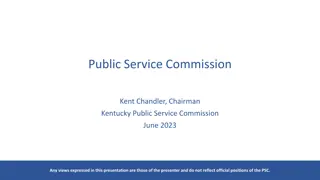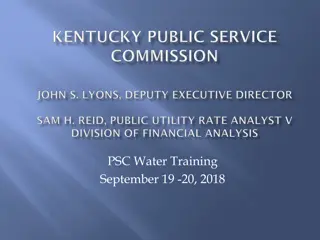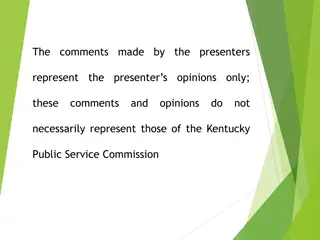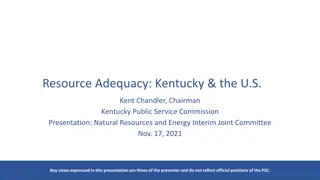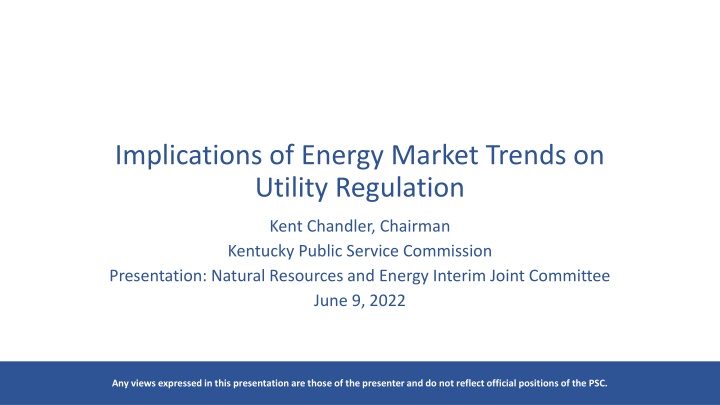
Implications of Energy Market Trends on Utility Regulation
Explore the presentation by Kent Chandler, Chairman of the Kentucky Public Service Commission, on the implications of energy market trends on utility regulation. Learn about the mission of the PSC, its role as an independent regulatory agency, and the impact of energy market trends on rates, service, and regulatory activities. Gain insights into key regulatory mechanisms such as the Fuel Adjustment Clause and Integrated Resource Planning.
Download Presentation

Please find below an Image/Link to download the presentation.
The content on the website is provided AS IS for your information and personal use only. It may not be sold, licensed, or shared on other websites without obtaining consent from the author. If you encounter any issues during the download, it is possible that the publisher has removed the file from their server.
You are allowed to download the files provided on this website for personal or commercial use, subject to the condition that they are used lawfully. All files are the property of their respective owners.
The content on the website is provided AS IS for your information and personal use only. It may not be sold, licensed, or shared on other websites without obtaining consent from the author.
E N D
Presentation Transcript
Implications of Energy Market Trends on Utility Regulation Kent Chandler, Chairman Kentucky Public Service Commission Presentation: Natural Resources and Energy Interim Joint Committee June 9, 2022 Any views expressed in this presentation are those of the presenter and do not reflect official positions of the PSC.
PSC Mission To foster the provision of safe and reliable service at a reasonable price to the customers of jurisdictional utilities while providing for the financial stability of those utilities by setting fair and just rates, and supporting their operational competence by overseeing regulated activities. 2
Public Service Commission Independent Regulatory Agency Three-member Commission Quasi-judicial function Regulates rates and service provided by jurisdictional utilities: 1,100 jurisdictional utilities Water and sewer utilities (small systems comprise the bulk of regulated utilities) Natural gas distribution systems and intrastate pipelines Electric utilities (investor-owned and jurisdictional cooperatives) Telecommunications (small number) Does not regulate municipal utilities except for gas pipeline safety. Does not regulate cooperatives served by TVA. 3
ReliabilityService and Rates Since 1934, the primary statutory directive of utility regulation in Kentucky revolves around: Rates Fair, just and reasonable Service Adequate, efficient and reasonable Most everything in retail utility regulation comes back to one or both of these principles. 4
Energy Market Trends: Implications on Utility Regulation Current and emerging trends make each of these more complex relative to prior decades: Fuel Adjustment Clause( FAC ) (807 KAR 5:056) Integrated Resource Planning (807 KAR 5:058) Certificate of Public Convenience and Necessity (KRS 278.020(1)) Rate Cases 5
Fuel Adjustment Clause (FAC) The FAC regulation has been in effect for 40 years. The FAC regulation allows jurisdictional utilities to reflect, through a line item on customers bills, the incremental or decremental cost of purchased power and/or fuel. Expenses incurred in a particular month appear in a subsequent month. Fuel costs make up a significant portion of the cost of providing electricity. For instance, in 2021, Kentucky Utilities, the largest utility in the Commonwealth, had approximately $1.64B in retail sales, while of that, $500M, or almost 1/3 of sales, was a pass through of fuel costs. As we ve seen in the last year, fuel expenses can fluctuate widely. Compared to the past 10 years, all electric and natural gas utilities have experienced higher fuel and purchased power costs in recent months. 6
Fuel Adjustment Clause- How it works The incremental or decremental amount of the FAC is set against a baseline fuel cost that is otherwise recovered through base rates- e.g. the customer and kWh charge. If the utility s fuel costs in a given month are above the baseline, the FAC appears as a per-kilowatt-hour surcharge (increment). If fuel costs fall below the baseline, the FAC appears as a per-kilowatt-hour credit (decrement). Utilities are required to fully document all of their fuel costs, including submitting fuel purchase contracts, fuel bid sheets and other materials to the PSC. The PSC reviews a utility s FAC filings, including conducting a detailed review every six months and then a final review, which occurs at two-year intervals. During its review, if the PSC determines costs to be unjustified due to improper calculation or application of the charge or improper fuel procurement practices, the PSC may disallow recovery of those costs and order a refund to customers. 7
Integrated Resource Planning Integrated Resource Planning (807 KAR 5:058) prescribes rules for regular reporting and commission review of load forecasts and resource plans of electric utilities to meet future demand with an adequate, reliable supply of power within their service areas. Filed every three years 15-year planning horizon includes historical and projected usage, resource, and financial data, and other operating performance and system information. IRPs include summary of planned resource acquisitions, new power plants, transmission improvements, etc. Plans are reflective of expected data- fuel, environmental and operational costs play a huge role in resource choices to serve load 8
Certificate of Public Convenience and Necessity Prior to construction or acquisition of any major facility, a utility must apply for a CPCN. Burden of proof lies with the applicant. Must show need for the proposed facility and an absence of wasteful duplication. Utility must show it has reviewed all reasonable options, such as various types of new facilities. Least cost principle flows from the absence of wasteful duplication. Long- term costs also must be considered. Cost of fuel is a direct input into the calculation of operating cost of resources. If fuel cost for a particular resource is expected to increase relative to other types of resources, models may not choose that resource based on fuel cost and fuel risk. 9
Regulatory Considerations Plant retirements end of useful life; cost of continuing to operate is more expensive than replacement generation Reliability and Resource Adequacy Effective date and impact of anticipated environmental regulations (uncertainties court challenges, administration changes, etc.). Technical viability and costs of emerging technologies Impact of demand response and other distributed energy resources (customer-sited generation) Purchased power versus steel in the ground Wholesale markets Distribution System Planning 10
Emerging TrendsGeneration Options. What is available? Wind Few places in Kentucky have adequate wind speeds and topography Solar Requires about 6-10 acres per MW, less reliability contribution in winter months Nuclear Currently unlikely, however emerging, advanced technologies could alter viability Coal New units unable to be built, primarily because of NSR requirements Natural Gas Often chosen by generation modeling as least-cost resource, but risks exist around ability to site infrastructure and actual useful life Energy Efficiency/Demand Side Management plenty of cost-effective amounts available, but inability to actually produce electricity Batteries limited duration (4 to 8 hours) and relatively expensive Hybrid Resources Promising, but relatively new Hydrogen Not yet proven to be cost-effective or readily available 11
Kentucky's Current Electricity Generation Profile 0.56 7 23.4 68.93 Natural Gas Coal Hydro RE 12












